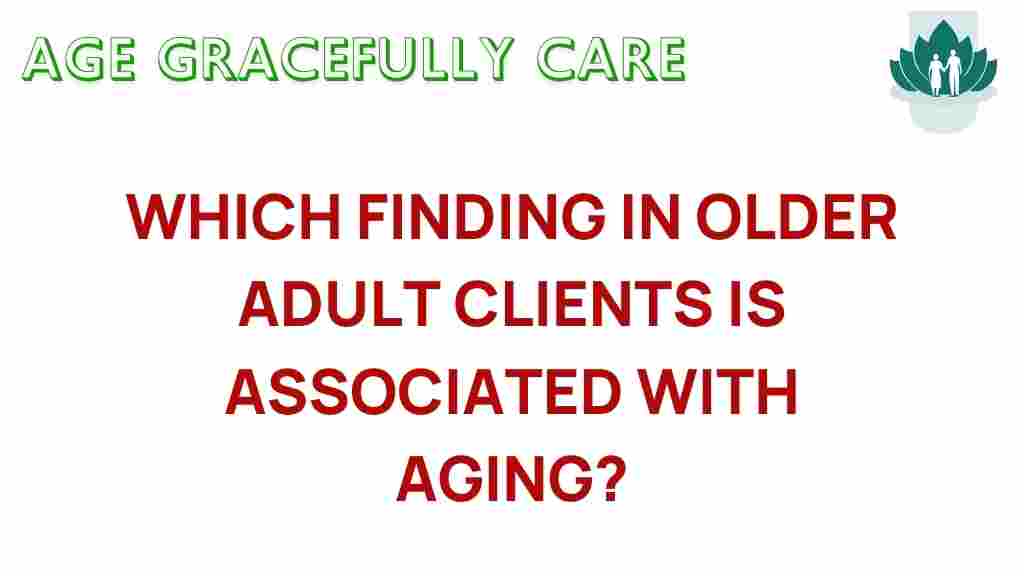Unraveling the Hidden Signs of Aging in Older Adults
Aging is a natural process that affects everyone, but the signs of aging can manifest differently in older adults. Understanding these signs is crucial for maintaining health and wellness as we age. This article will delve into the physical and mental changes that accompany aging, explore the importance of longevity, and provide tips for senior care. Whether you’re a caregiver, family member, or an older adult yourself, recognizing the hidden signs of aging can empower you to take proactive steps toward better health.
Understanding the Signs of Aging
Aging can be divided into two categories: intrinsic and extrinsic factors. Intrinsic aging refers to the natural biological processes that occur over time, while extrinsic aging is influenced by environmental factors, lifestyle choices, and overall wellness. Here are some common signs of aging to watch for:
- Physical Changes: These include wrinkles, sagging skin, gray hair, and changes in body composition.
- Changes in Vision: Many older adults experience vision problems such as cataracts or age-related macular degeneration.
- Hearing Loss: Gradual hearing loss is a common sign of aging.
- Cognitive Changes: Memory lapses and slower processing speeds can occur as we age.
- Decreased Mobility: Joint stiffness and reduced strength can lead to mobility issues.
Physical Changes in Older Adults
As older adults age, they may experience various physical changes that can affect their overall health and wellness. Here are some key areas to consider:
Skin and Hair
The skin loses elasticity and moisture, leading to wrinkles and sagging. Hair also undergoes changes, often turning gray and thinning. Protecting skin health with moisturizers and sun protection can help mitigate some of these effects.
Muscle Mass and Strength
Muscle mass naturally declines with age, a condition known as sarcopenia. This loss of strength can affect balance and mobility, increasing the risk of falls. Regular strength training exercises can help counteract this decline.
Bone Density
Older adults may experience a decrease in bone density, making them more susceptible to fractures and osteoporosis. Calcium and vitamin D are essential for maintaining bone health.
Mental Health and Aging
Mental health is just as important as physical health in older adults. Aging can bring about various psychological changes, including:
- Memory Issues: Mild cognitive impairment is common, but significant memory loss may indicate dementia or Alzheimer’s disease.
- Depression and Anxiety: Changes in lifestyle, loss of loved ones, or health issues can contribute to mental health challenges.
- Social Isolation: Many older adults experience loneliness, which can affect their emotional well-being.
Promoting Longevity and Wellness
To enhance longevity and improve overall wellness, it’s essential to adopt healthy habits. Here are some effective strategies:
- Regular Exercise: Engage in a mix of cardiovascular, strength, and flexibility exercises.
- Balanced Diet: Focus on a diet rich in fruits, vegetables, whole grains, lean proteins, and healthy fats.
- Stay Hydrated: Drink plenty of water to maintain hydration and support bodily functions.
- Regular Check-Ups: Schedule routine health screenings and consultations with healthcare providers.
- Mental Stimulation: Engage in puzzles, reading, or learning new skills to keep the mind sharp.
Step-by-Step Process to Monitor Signs of Aging
Recognizing and addressing the signs of aging requires a proactive approach. Here’s a step-by-step guide:
Step 1: Self-Assessment
Take time to assess your physical and mental health regularly. Consider keeping a journal to track any changes in your body or mood.
Step 2: Consult Healthcare Professionals
Regular check-ups with healthcare professionals can help identify potential issues early. Discuss any concerns regarding physical or mental health.
Step 3: Adopt Healthy Lifestyle Changes
Implement changes to your daily routine that promote health and wellness. This may include diet modifications, exercise, and stress management techniques.
Step 4: Stay Connected
Maintain social connections to combat loneliness and promote mental health. Join community groups or engage in activities with friends and family.
Troubleshooting Common Aging Issues
Many older adults face common challenges related to aging. Here’s how to troubleshoot some of these issues:
Issue 1: Joint Pain
If you experience joint pain, consider incorporating low-impact exercises like swimming or yoga. Consult with a physical therapist for personalized exercises that can help.
Issue 2: Memory Loss
To improve memory, engage in activities that challenge your brain, such as crossword puzzles or learning a new language. Ensure you’re getting enough sleep, as it’s crucial for cognitive function.
Issue 3: Depression
If you’re feeling persistently sad or anxious, seek professional help. Therapy and medication can be effective in managing mental health issues.
Issue 4: Nutrition
If you struggle with maintaining a balanced diet, consider meal planning or consulting a nutritionist. They can help create a meal plan that suits your needs and preferences.
Conclusion
Aging is an inevitable part of life, but understanding the hidden signs of aging can empower older adults to take charge of their health and wellness. By recognizing the physical and mental changes that come with aging, individuals can implement strategies to promote longevity and enhance their quality of life. Remember, it’s never too late to adopt healthier habits. Stay proactive about your health, and don’t hesitate to reach out for support when needed.
For more information about senior care and wellness strategies, visit this resource. Staying informed and connected is key to navigating the aging process successfully.
Additionally, you can explore more about mental health initiatives on Mental Health America to learn how to improve your mental wellness as you age.
This article is in the category Health and created by AgeGracefullyCare Team
